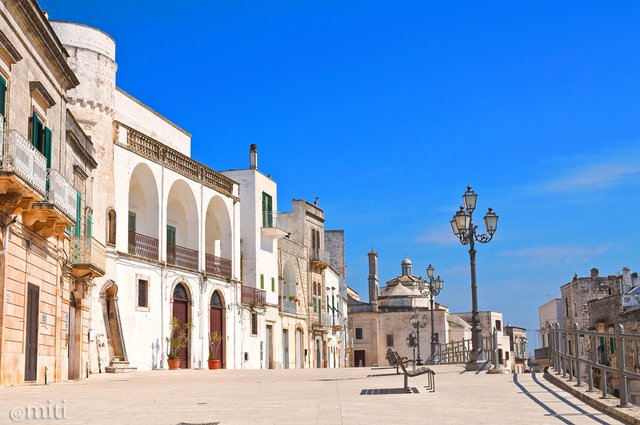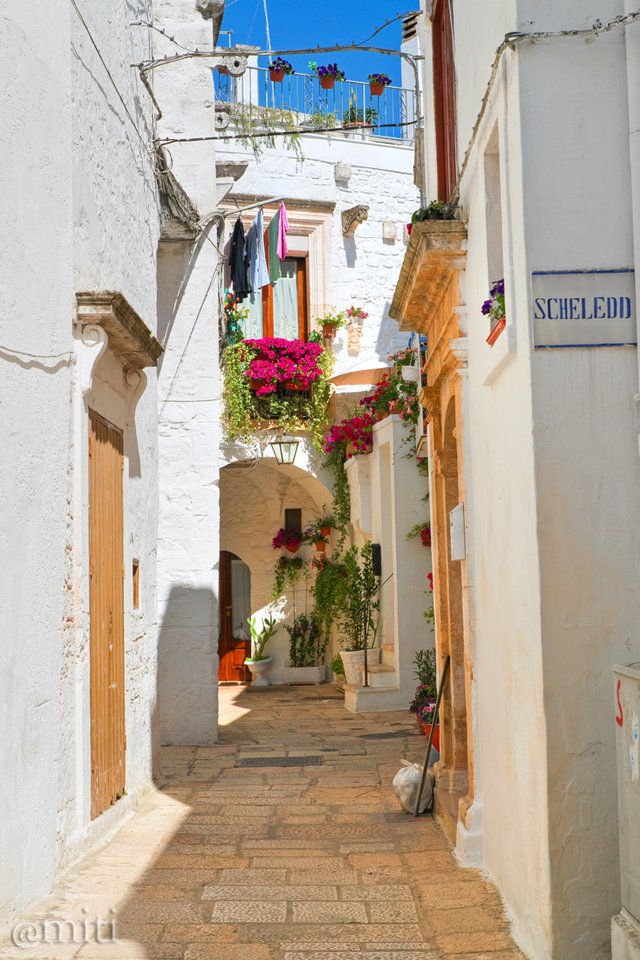A Journey through Italy: one photo every day #92 - CISTERNINO [ENG/ITA]

A panoramic view of Cisternino (Author's photo - All rights reserved)
Vista panoramica di Cisternino (Immagine dell'autore - tutti i diritti sono riservati)



Ciao a tutti,
questo è un viaggio attraverso l'Italia. Posterò una foto al giorno con una brevissima descrizione. Spero vi piaccia!

Cisternino è un piccolo borgo della provincia di Brindisi, nella regione italiana meridionale della Puglia. Svetta sulla Valle d'Itria, un terreno reso unico dai suoi numerosi trulli.
Secondo la tradizione, Sturnoi, il compagno di Diomede, fondò questa città alla fine della guerra di Troia. Forse distrutta nel 216 aC durante le incursioni di Annibale in Puglia, la città tornò a vivere nell'VIII secolo con un gruppo di monaci basiliani, rifugiati provenienti dall'Oriente, che costruirono un'abbazia di rito greco chiamata San Nicola Cisturnino, proprio dove oggi sorge la chiesa Madre.
Il villaggio, già abitato in epoca neolitica, ha visto susseguirsi il dominio normanno-svevo, aragonese e borbonico.
Il Borgo è un esempio di "architettura spontanea" progettata non da architetti seguendo un piano prestabilito, ma piuttosto da relazioni umane per adattarsi, tra case bianche e palazzi, strade laterali e vicoli punteggiati di gerani, archi, colonnati minuscoli, fregi in pietra e scalinate.
Nel centro storico edifici storici di rilievo sono la torre e la chiesa sulla piazza. La torre Normanno-Sveva, recentemente restaurata, fu costruita nell'XI secolo dai Normanni ed è alta 17 metri. Fu in gran parte ricostruita alla fine del XIV secolo e fu più tardi rimaneggiata più volte. Sulla sua sommità è posta una piccola statua di San Nicola benedicente.
La Chiesa di San Nicola, conosciuta come la Chiesa Madre, fu costruita nel 12 ° secolo rispetto alla precedente chiesa basiliana dell'VIII secolo, le cui fondamenta rimangono ancora. Anche la Chiesa Madre subì cambiamenti nel corso dei secoli.
Accanto ad essa, una chiesa primitiva risalente all'anno 1000 circa è stata recentemente scoperta sotto la piccola chiesa del Purgatorio.
Meritano una visita anche la piccola Chiesa di Santa Lucia (XVII secolo), il Palazzo Vescovile, costruito nel 1560, con una facciata tardorinascimentale, il Palazzo del Governatore (sec. XVI) che ha un elegante fronte con tre balconi e decorazioni ed elementi rinascimentali ; le case delle famiglie nobili Pepe e Cenci; fuori dalle mura, le due torri cilindriche costruite durante il dominio angioino, una delle quali è annessa a Palazzo Amati, l'altra a Palazzo Capece-Ricci; la Chiesa di San Cataldo, completata nel 1783 in stile barocco, con la sua bella facciata, la Chiesa di San Quirico, costruita tra il XVII e il XVIII secolo e il Santuario della Madonna d'Ibernia, un sito archeologico con rovine romane e medievali .
Cisternino appartiene al circuito de 'I borghi più belli d'Italia'. Ha anche ricevuto la Bandiera Arancione (un premio turistico nazionale).
Cosa vedere: il centro storico, la Torre Normanno-Sveva, la chiesa di San Nicola, la chiesa del Purgatorio, la chiesa di Santa Lucia, la torre dell'orologio, il palazzo vescovile, il palazzo del governatore, il Palazzo Amati, il palazzo Capece-Ricci, la chiesa di San Cataldo, la chiesa di San Quirico, il santuario della Madonna d'Ibernia, il Convento dei Frati Cappuccini con la Chiesa di Sant'Antonio, il Palazzo Lagravinese.

Hello everyone,
I began a Photo Journey through Italy. I will post one photo every day with a little note of explanation. I hope you like it!

Cisternino is a small town in the province of Brindisi, in the Southern Italian region of Puglia. It reigns over the Itria Valley, a terrain rendered unique by its numerous trulli houses.
According to tradition, Sturnoi, Diomedes’ companion, founded this town at the end of the Trojan War. Perhaps destroyed in 216 BC during the raids of Hannibal in Apulia, the town returned to live in the 8th century with a group of Basilian monks, refugees from the East, who built an abbey of Greek rite called St. Nicholas Cisturninum, just where the church Matrix stands nowadays.
The village, already inhabited in Neolithic times, has seen a succession of Normanic-Swabian, Aragonese and Bourbon rule.
The Borgo is an example of “spontaneous architecture” designed not by architects following a preestablished plan, but rather by human relations to be fit together, among chalky-white homes and buildings, side streets and alleyways dotted with geraniums, arches, tiny colonnades, stone friezes and stairways.
In the old town the finest historical buildings are the tower and the church on the square. The recently restored Norman-Swabian tower was built in the 11th century by the Normans, and is 17 meters tall. It was largely rebuilt in the late 14th century and was later remodeled several times. A statue of a blessing St. Nicholas stands at the top.
The Church of San Nicholas, known as the Mother Church, was built in the 12th century over the previous 8th century Basilian church, whose foundations still remain. The Mother Church also underwent changes over the centuries.
Next door, a primitive church dating back approx. 1000 was recently discovered underneath the small Church of Purgatorio.
Also worthy of a visit are the small Church of Santa Lucia (17th century), the Bishop’s Palace, built in 1560, with a late Renaissance façade, the Governor’s Palace (16th cent.) which has an elegant front with three balconies and Renaissance decorative elements; the houses of the noble Pepe and Cenci families; outside the walls, the two cylindrical towers built during the Anjou nomination - one of which is annexed to Palazzo Amati, the other to Palazzo Capece-Ricci; the Church of San Cataldo, completed in 1783 in Baroque style, with its beautiful dynamic façade, the Church of San Quirico, constructed between the 17th and 18th centuries and the Sanctuary of the Madonna d’Ibernia, an archaeological site with Roman and medieval ruins.
Cisternino is one of Italy's most beautiful villages ('I borghi più belli d'Italia'). It has also been awarded the Orange Flag (a national tourist award).
Thing to see: the Historical center, the Norman-Suevian tower, The Church of San Nicholas, the Church of Purgatorio, the Church of Santa Lucia, the Clock Tower, the Bishop’s Palace, the Governor’s Palace, the Amati palace, the Capece-Ricci palace, the Church of San Cataldo, the Church of San Quirico, the Sanctuary of the Madonna d’Ibernia, the convent of Capuchin monks with the Church of Sant’Antonio, the Lagravinese palace.

| Tipo di foto / Category | Paesaggio / Landscape view |
| Esposizione / Settings | 1/400 sec, ISO 200, f/11 |
| Camera | Nikon D5000 |
| Lente / Lens | Tamron SP 17-50mm f/2.8 XR Di II LD |
| Filtro / Filter | Polarizzatore Hoya / Hoya Polarizing filter |
| Cavalletto / Tripod | Manfrotto MKC3-P01 |
| Località / Location | Cisternino (Brindisi), Italia |
| Software | Photoshop |


Alleyway in the historical center (Author's photo - All rights reserved)
Vicolo del centro storico (Immagine dell'autore - tutti i diritti sono riservati)
love this photo - very meditarrenean
Yes, we are in that area.
Congratulations, Your Post Has Been Added To The Steemit Worldmap!
Author link: http://steemitworldmap.com?author=miti
Post link: http://steemitworldmap.com?post=a-journey-through-italy-one-photo-every-day-92-cisternino-eng-ita
Want to have your post on the map too?
Wow very nice your professional work
Thanks
Впечатляющая фотография!
You got a 32.02% upvote from @ocdb courtesy of @miti!
Just beautiful. I wish I could visit too!
you have nice skill of photography.. and the camera Nikon D5000 is quite good.. very good keep going.
Thanks
Un territorio molto famoso per i suoi trulli e che ho avuto modo di ammirare in vari programmi televisivi.
Nell'ultima foto colori accesi e neutri a contrapporsi, in una foto molto artistica. Ancora una volta i panni tesi, sinonimo di vita cittadina.
Eh si... panni stesi = fotografo felice :-)
wow Italy is mesmerizing.
Yes.. Indeed!
wow a very wonderful and breathtaking view of the cisenino castle of italy. the building looks heart touching and attractive. thanks for sharing.
You're welcome.